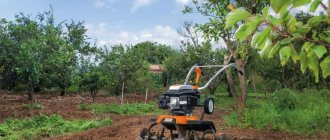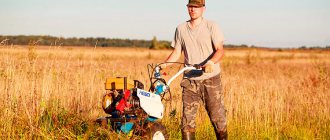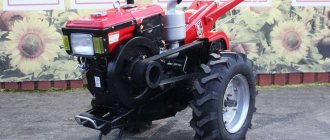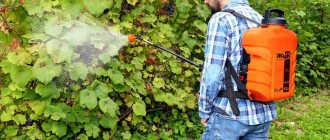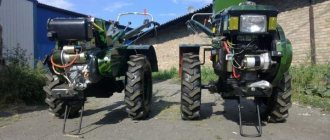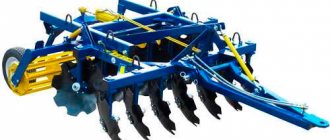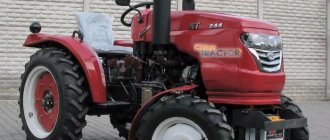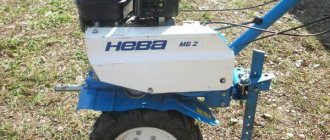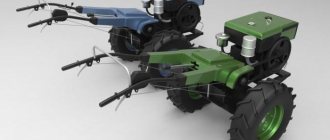The main occupation of most summer residents is working in the garden: planting seeds and harvesting, weeding, cultivating, loosening, harrowing. It is difficult to do the entire range of necessary activities manually. In addition, it takes a lot of time. To ease the hassle of dachas, owners are increasingly stocking up on cultivators - the most popular and efficient unit for working on the land.
However, the wide range of these mechanisms can confuse buyers. Choosing a model that is good in all respects is not so easy. So, we will consider below, based on the numerous reviews of those who have already tried them, which petrol cultivator for the dacha is better in terms of price and quality.
Preparing the walk-behind tractor for cultivating the site
Step one. Installation of cutters
Photo 2
To cultivate the soil, instead of transport wheels, you must install a set of cutters on the walk-behind tractor on the left and right sides, as shown in photo 2 (cutters are installed on the right side). One set of cutters includes eight knives. This number and arrangement of knives on the axis gives the most effective result of tillage.
Photo 3
Please note that when installing knives, the cutting part should be directed forward, in the direction of movement of the walk-behind tractor. Please note that the working part of the knife should not be sharp, since in this case the walk-behind tractor will not move forward, but will constantly bury itself in the ground, since the cutters will not loosen the ground, ensuring engagement with the soil, but will simply cut it.
Step two. Installing the opener
Photo 4
Photo 4 shows how an earring is installed on the walk-behind tractor, to which the opener is attached.
Photo 5
Photo 5 shows the opener. What is it and what is it for? The coulter is a bar with vertically located holes, with the help of which we can adjust the depth of the tillers of the walk-behind tractor during the cultivation of the land.
Photo 6
We install the opener into the shackle and fasten it using a bushing and cotter pins into the second hole (counting from the bottom of the opener). When installing the coulter in this way, the depth of the tillers of the walk-behind tractor into the soil will be approximately 20 cm. This depth is quite sufficient for high-quality tillage of the soil for subsequent planting of cultivated plants on the land plot.
To change the depth of tillage, the coulter can be attached to the shackle as follows:
- To increase the depth of tillage, we lower the coulter down and attach it to the shackle through the upper holes.
- To reduce the depth of tillage, raise the coulter upward and attach it to the shackle through the holes located below.
Photo 7
The cutters and coulter are installed and the walk-behind tractor is ready for work. To determine the quality of adjustment of the depth of the cutters, it is necessary to perform a control run of the walk-behind tractor over the land plot and make sure that the walk-behind tractor operates without load during cultivation and the depth of tillage meets our requirements.
Plowing a walk-behind tractor with a plow
Experienced experts advise novice gardeners to begin their plowing work by stretching the cord along the first row. This simple procedure will make the furrow even.
When plowing other rows, the walk-behind tractor wheel will pass along the finished furrow of the first row. For this reason, all other furrows will be smooth; no additional measures are required.
In order to make plowing the garden convenient, the procedure must be carried out along a long row. This will help eliminate additional effort.
Plow adjustment
Plowing quality will not be good if the plow is not adjusted correctly. To ensure normal operation it is necessary:
- The minitractor needs to be raised slightly above the ground. This can be achieved by selecting small stands 15 cm high (boards or bricks). The greater the required depth of plowing the soil, the higher the stands should be: if the operation is carried out in the fall, the height of the stands is made 20-25 cm. In the spring, the height is left lower - 10-20 cm.
- Install the hitch without deviating from the instructions of the equipment manufacturers. The edge of the ploughshare must be in full contact with the ground, while the plow stand must be installed vertically and the beam horizontally.
- By turning the handle at the base of the walk-behind tractor to the left, you can process the not yet plowed strip. This will also help prevent the car from getting stuck. When turning the unit, you must try to ensure that its right wheel remains opposite the already completed furrow.
Plowing depth
To achieve the required plowing depth, you need to pay attention to the weight of the walk-behind tractor. It is better to choose the one that is heavier. You can add weight yourself by attaching additional weights to the wheels.
The first furrow is made no more than 10 cm deep. You need to plow slowly and without putting pressure on the machine. If it happens that the equipment overheats, it is turned off for half an hour.
In relatively soft soil, the metal knife goes into the ground at the distance of a shovel bayonet. If the ground is harder, it will be difficult to achieve this depth the first time. Therefore, the plowing operation is carried out in two or even several stages, each time lowering the plow deeper.
Very hard soil is easier to plow with a walk-behind tractor when wet.
Plowing with a plow
The main plowing should begin only after the trial version has been completed and all the shortcomings have been taken into account.
Two adjacent plowed strips should be spaced no more than 10 cm apart. Adjacent furrows should not cover one another with soil. The right wheel of the machine should be in the middle of the blade of the finished furrow, and not along its base.
By slightly increasing the speed, you can ensure that the surface of the plowing becomes smoother, without lumps. The plow makes it possible to make furrow depths of 15-20 cm.
You can plow the soil efficiently with a walk-behind tractor thanks to the high-speed mode. It is best when the walk-behind tractor has several gears so that the owner can choose the most convenient one for himself.
Cultivating a plot using a walk-behind tractor
Step one
Photo 8
To obtain high quality tillage with milling cutters, it is necessary to select the correct speed mode. Typically, there are two gears to move the walk-behind tractor forward:
- Low is first gear.
- Overdrive is the second gear.
Unlike plowing, when cultivating the soil, the walk-behind tractor must operate at increased speed, so in this case it is necessary to select a higher gear to increase the rotation speed of the cutters.
Selecting a higher gear reduces the load on the walk-behind tractor engine, and with an increase in the rotation speed of the cutters, the quality of loosening the soil significantly improves.
Step two
Photo 9
After passing the first strip, we check the depth of tillage. If the depth is satisfactory, then you can continue cultivating the land. The passage of the second strip must be done so that the cutters follow the line left by the coulter, since an untreated area of soil remains between the cutters of the walk-behind tractor.
Note:
When performing work on cultivating a vegetable garden, you do not need to press the steering wheel down, you should not push the walk-behind tractor forward - all this can lead to the walk-behind tractor starting to bury itself in the ground.
Attachments
Review of attachments supplied by the plant for completing small-sized agricultural machinery:
- Welded steel wheels with V-shaped plates on the tread that improve traction. The units are installed on standard equipment hubs instead of wheels with rubber tires; are secured with standard bolts.
- Prefabricated metal houndstooth cutters and plows designed for plowing and loosening soil. The size of the elements is selected according to the existing walk-behind tractor model; plows differ in the installation method and the configuration of the working share.
- Disc hillers mounted on movable brackets. Some modifications are equipped with rolling bearings, which reduce rotational force.
- Snow plows equipped with a rotating mechanism with a lock.
- Devices for mechanizing potato digging.
- Hitches that allow you to install a trailer. A seat is mounted on the drawbar for the operator, who changes the direction of movement and speed using the handles.
- Protective discs installed on the ends of the work rollers. The parts protect shrubs or trees from damage by cutters.
What to do if the equipment gets stuck in the ground?
In this case, you need to swing the equipment in different directions, which will gradually release it from the soil. It is worth noting that there are a number of motorized cultivators that will perform excellently on hard virgin soil. Usually, of course, during the initial plowing of stubborn virgin soil, a plow is used. But if the cultivator has good power, then it can also cope with such soil using conventional cutters. And in this case, many owners may encounter a problem with such soil cultivation: the unit begins to bounce due to the hardness of the earth. To hold the equipment in place and give it greater stability, you can use additional weight.
Specifications
| Engine | Four-stroke, air-cooled carburetor SK-12 |
| Engine power | 11.0 hp |
| Volume | cm³ |
| Clutch | Friction, multi-disc, permanently closed, operating in oil, manually operated |
| Transmission | Mechanical, stepped with constant gear meshing |
| Number of speeds | 4 forward/2 reverse |
| Max. forward speed in 1st, 2nd, 3rd, 4th gear | 2.15, 3.8, 5.35, 9.6 km/h |
| Max. reverse speed at 1.2 gear | 2.5, 4.46 km/h |
| main gear | Pair of spiral bevel gears |
| Differential | Gear, bevel with 2 satellites with forced locking |
| Final drives | Single-stage spur gears |
| Chassis system | Wheels on pneumatic tires |
| Tire size | 150*330mm |
| Air pressure in walk-behind tractor tires | 0.08-0.12 (0.8-1.2) MPa (kgf/cm²) |
| Track (adjustable) | 400, 650, 700mm |
| Ground clearance | 300mm |
| Turning radius (with 450mm track) | 1 meter |
| Processing depth | 300mm |
| PTO | There is |
| Shaft speed | 1000rpm |
| Weight of towed trailer with cargo | 650kg |
| PTO shank rotation speed at engine crankshaft speed 314 rad/s (3000 rpm) | 104.6 (1000) rad/s (rpm) |
| Steering | Rod, adjustable in height with the ability to change to reverse and position to the left or right at an angle of 15° |
| Overall dimensions (L*W*H) | 1885*850*1010mm |
| Weight | 148kg |
Reasons for deep cutting cutters
Photo 10
In photo 10 you can see that the walk-behind tractor has stopped moving forward, the cutters have gone very deep into the layer of earth. To put it simply, the walk-behind tractor is buried in the ground! Why might this happen? Below are the main reasons why a walk-behind tractor breaks down, as well as ways to eliminate them.
1. The soil on the site is very moist and clogs the knives; you need to wait until the soil dries.
2. The coulter is deeply buried in the soil; it is necessary to adjust the coulter.
3. Insufficient speed, it is necessary to set the gas regulator to the maximum value and check the speed mode (select a higher gear for the walk-behind tractor).
4. The soil in the area is highly compacted, so it is necessary to cultivate the area in two times:
- Primary tillage with minimal coulter depth.
- Final tillage is carried out when the coulter is buried to the required depth.
5. The cutters of the walk-behind tractor are installed incorrectly; check that the cutters are installed correctly.
These are the most common reasons why the tillers of a walk-behind tractor go very deep into the ground and the walk-behind tractor stands still.
Working with a walk-behind tractor begins with setting it up. It depends, first of all, on the area of the plowed area, as well as on the quality of the soil. Some universal rules will help you set up your equipment correctly:
- The recommended diameter of the lugs is 50-60 cm, and the width is 18-20 cm. If the dimensions are smaller than those specified, the equipment will not make it possible to make an even furrow; it will be driven on different sides.
- It is preferable to choose a solid wheel rim so that earth does not accumulate on it.
- The weight of the unit must be less than 70 kg, otherwise it will constantly slip.
- The position of the machine itself when plowing should be such that its entire base is completely in contact with the soil. Otherwise, the plowing depth will either be too great, or, conversely, plowing will not work at all.
- When attaching the plow to the coupling device, the fastening nuts are not fully tightened. This leaves the possibility of further regulation. Using just two pins, you can easily connect the plow to the mounting eyelet.
Walk-behind tractor or cultivator - what's the difference?
Owners of summer cottages are often faced with the choice of what is better to buy, a cultivator or a walk-behind tractor. Both units have their own characteristics and advantages that you need to know about so as not to make a mistake with the purchase.
The walk-behind tractor is favored by its power, productivity, and versatility. With its help, you can perform almost all types of agricultural work: plowing, hilling, cultivation, harvesting and transporting crops, applying fertilizers, planting seeds, etc. This is possible thanks to the presence of a special mount for installing various attachments. This technique is suitable for processing fairly large areas.
The cultivator attracts with its small size, lighter weight, fuel economy, and greater maneuverability. Some models also have the ability to hook up different types of attachments. You can also find devices equipped with a gearbox with reverse speed. And the cost cannot be ignored in favor of the cultivator; it is often several times lower than the prices of walk-behind tractors.
Technique for proper digging of a vegetable garden
First of all, the site must be properly prepared by clearing it of weeds, stones and various types of debris. After this, stretch the so-called orientation cord along the first row of the site. This manipulation is necessary in order to make the arable row as even as possible. Then prepare the device. To check how correctly the adjustments have been made, it is recommended to plow a test plot of a minimum area. Moving to the main area, place the walk-behind tractor or cultivator at the beginning of the furrow.
Cultivator treatment of a trial plot of minimal area
When starting arable work, slightly deepen the device into the soil, lightly pressing it downwards. Next, follow the walk-behind tractor along the guide cord, holding the handles of the walk-behind tractor. Make sure that the mechanism runs in a straight line and do not allow it to sink excessively into the soil. When the length of the furrow comes to an end, you need to make a U-turn and continue plowing in the opposite direction. To cultivate the land as uniformly as possible, it is necessary to ensure that the speed of movement of the mechanism is low, and the rotation speed of its cutters, on the contrary, is quite high.
Features of virgin soil plowing
How to plow virgin soil correctly? For high-quality processing you will need:
- Motoblock unit weighing at least 100 kg. If it is lighter, the plow simply will not budge.
- A rotary plow, which includes a cutter, a gearbox for connecting to a walk-behind tractor, and transport wheels.
- It would not be superfluous to use special weighting in the form of ballast.
The work of plowing virgin soil must be carried out in stages, each time going deeper and deeper. In addition, soil moisture will make it easier to work with.
Good to know! The direction of plowing needs to be changed every year, since the soil layer is constantly shifting.
Models of walk-behind tractors such as Neva, MTZ, Khoper, and Centaur are in great demand among gardeners. In addition to plowing, they also provide for other agricultural work.
Potatoes are often hilled with walk-behind tractors, that is, a hiller is used instead of a plow. It penetrates into the ground to a shallower depth, thereby differing from the first.
It is also used for harvesting. For this, a special canopy is used that raises the ground. Then it is poured through the grate, as if through a sieve, and only the root vegetables remain on the surface.
comparison table
If you have not yet decided which gasoline cultivator is best to choose in 2020-2021 for your dacha, then you can compare the technical characteristics of each model, which we have indicated in the comparison table.
| Model | Engine capacity, cubic meters cm | Tillage width, cm | Milling cutter rotation speed, rpm | Cultivation depth, cm | Fuel tank volume, l | Average price, rub. |
| Mobile K MKM-MINI | 98 | 22,50-42 | 140 | 21,5 | 1,6 | 17 890 |
| Daewoo Power Products DAT 3530 | 57,2 | 26 | 140 | 22 | 1 | 12 395 |
| ELITECH KB 60N | 196 | 35-85 | n/a | 32 | 3 | 20 695 |
| CHAMPION BC6712 | 196 | 30-85 | 130 | 33 | 3,6 | 21 940 |
| Huter GMC-6.5 | 196 | 30-90 | 190 | 32 | 3,6 | 22 512 |
| Hammer RT-50A | 159 | 50 | – | 36 | 1,2 | 24 352 |
| Hyundai T 850 | 196 | 80 | 114 | 30 | 3,6 | 29 511 |
| Neva MK-200-N5.0 | 160 | 65-100 | 28-120 | 16 | 2 | 32 595 |
| Caiman TRIO 70 C3 | 212 | 30-90 | 208 | 32 | 3,6 | 36 695 |
| ECHO TC-210 | 21,2 | 21 | 277 | 25 | 0,5 | 30 925 |
| Husqvarna TF 338 | 212 | 95 | 53-97 | 30 | 4,8 | 39 945 |
Which motor cultivator to choose: main characteristics, brief overview of models and reviews
Novice gardeners and vegetable gardeners often have little understanding of the difference between a motor-cultivator and a walk-behind tractor. The walk-behind tractor has a complex design, is equipped with a large number of attachments and can be used not only for tillage, but also for solving a number of other problems.
The cultivator is intended exclusively for soil cultivation. This functional limitation is justified by the significantly lower cost of such equipment. Light weight and compact dimensions make the cultivator indispensable for working in a limited area, for example, in a greenhouse, where it would be difficult even to simply roll a walk-behind tractor. It is important that this device will be easier for women and older people to operate.
Plowing the land with a walk-behind tractor with an adapter
The quality of plowing and its convenience can be improved by turning the plow into a transport and arable module. To do this, it is attached to the frame of the adapter, not the walk-behind tractor. This type of plowing is easier and safer, but less maneuverable. The operating speed can be increased from 5 to 10 km/h.
Adapter – trailer to a walk-behind tractor or a mini tractor from a walk-behind tractor. The functionality of such a unit can be compared with the capabilities of a tractor. The range of tasks increases depending on the attachment.
Some models have a lever used for lifting. This makes controlling the mechanism easier and makes it possible to move it around the site.
What to look for when choosing?
You should pay close attention to some characteristics.
- The size of the cutter directly depends on the width of the grip - the wider the grip, the fewer rows, and, therefore, higher productivity. But a wide cutter is not suitable for small areas.
- The depth of plowing depends, on the one hand, on the weight of the cultivator, on the other, on the type of soil. How the land will be used is also important.
- The engine is characterized by displacement (cm3), power (horsepower or kilowatts), type of fuel (diesel, gasoline, electric drive or battery), brand and series.
- Fuel tank capacity (2.5-6 liters). As a rule, the capacity is calculated in such a way that the unit can produce fuel before the engine overheats.
- Body material and paint quality.
- Gearbox type – worm, chain, gear.
- The number of forward and reverse speeds is a characteristic that allows you to determine the possibility of processing heavy soils at the second speed (forward) and the possibility of reverse (reverse).
- Additional attachments and equipment: transport wheels, headlights, hiller, plow, cutter, etc.
Depending on the configuration, the price of the cultivator will change significantly, but the functionality will also be much wider.
Terms of use
The basis is to buy the right engine and see how it is installed on the walk-behind tractor. And also follow the instructions correctly and take care of the engine while it is running. The first thing you need to do before purchasing the product is to get advice from a specialist about the features of using the unit.
It is important to carefully read the installation and operating instructions so as not to make mistakes during operation. It is necessary to systematically carry out preventive maintenance - change the oil, clean components
When it is clear that the engine is not functioning stably, contact a service center for help. The guarantee document will be useful. There are many reasons for breakdowns, so if you don’t have repair skills, it’s best not to fix it yourself, so as not to worsen the situation. A professional will definitely find the reason, determine whether the oil seal on the crankshaft needs to be replaced, whether to use a different fuel, or whether the internal wire needs to be replaced.
Popular brands
China constantly monitors consumer demand by releasing its models to the market. It is not surprising that there are almost 80 brands of walk-behind tractors alone. Among them there are analogues of Russian and European manufacturers.
In a general review, the Yandex search engine shows that the most popular Chinese brand, by the number of queries, is ZUBR.
The multicultivator from China is available in three types. One of them is in a typical assembly. The second is distinguished by a gearbox, which the developers have significantly improved. The third type is complemented by water cooling, an improved gearbox and has a cutter.
The last two types have additional power, the frequency of which is 2.6 thousand revolutions per minute. ZUBR has an engine whose power reaches 8 hp. With. It has a water cooling system and has an unlocked differential. Differs in maneuverability. It has shown itself to be excellent in virgin soil conditions, in which a weighting agent is not required.
Another popular brand is ZIRKA. Heavy walk-behind tractors made in China are characterized by durability. In the manufacture of the gearbox, a very durable alloy of AC4B aluminum is used. Cast iron alloy is used to make a gearbox that can withstand different load changes. Alloy alloy is used in the manufacture of gears. The equipment is distinguished by maneuverability and power.
Another popular brand is KIPOR. The unit is improved with an air filter and an oil bath. These qualities allow the equipment to work in dusty conditions. The steering wheel rotates along an axis of 180 degrees, which emphasizes its maneuverability. The gearbox is equipped with hexagonal shafts. They are designed to accommodate universal multi-hole axle shafts. Thanks to this, there is a unique opportunity to change the wheel track width to either wide or narrow. Another advantage of KIPOR is the presence of so-called working bodies. The wheels are equipped with lugs.
